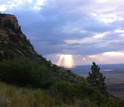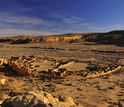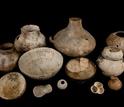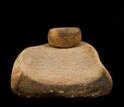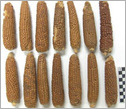News Release 14-082
Scientists chart a baby boom--in southwestern Native Americans from 500 to 1300 A.D.
Southwest U.S. experience holds lesson in over-population
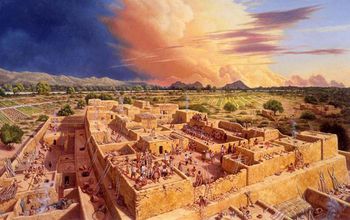
Reconstruction of life on a Hohokam platform mound in the Sonoran Desert in the 13th century A.D.
June 30, 2014
This material is available primarily for archival purposes. Telephone numbers or other contact information may be out of date; please see current contact information at media contacts.
Scientists have sketched out one of the greatest baby booms in North American history, a centuries-long "growth blip" among southwestern Native Americans between 500 and 1300 A.D.
It was a time when the early features of civilization--including farming and food storage--had matured to a level where birth rates likely "exceeded the highest in the world today," the researchers report in this week's issue of the journal Proceedings of the National Academy of Sciences.
Then a crash followed, says Tim Kohler, an anthropologist at Washington State University (WSU), offering a warning sign to the modern world about the dangers of overpopulation.
"We can learn lessons from these people," says Kohler, who co-authored the paper with WSU researcher Kelsey Reese.
The study looks at a century's worth of data on thousands of human remains found at hundreds of sites across the Four Corners region of the Southwest.
"This research reconstructed the complexity of human population birth rate change and demographic variability linked with the introduction of agriculture in the Southwest U.S.," says Alan Tessier, acting deputy division director in the National Science Foundation's (NSF) Directorate for Biological Sciences, which supported the research through NSF's Dynamics of Coupled Natural and Human Systems (CNH) Program.
"It illustrates the coupling and feedbacks between human societies and their environment."
CNH is also co-funded by NSF's Directorates for Geosciences and Social, Behavioral & Economic Sciences.
While many of the remains studied have been repatriated, the data let Kohler assemble a detailed chronology of the region's Neolithic Demographic Transition, in which stone tools reflect an agricultural transition from cutting meat to pounding grain.
"It's the first step toward all the trappings of civilization that we currently see," says Kohler.
Maize, which we know as corn, was grown in the region as early as 2000 B.C.
At first, populations were slow to respond, probably because of low productivity, says Kohler. But by 400 B.C., he says, the crop provided 80 percent of the region's calories.
Crude birth rates--the number of newborns per 1,000 people per year--were by then on the rise, mounting steadily until about 500 A.D.
The growth varied across the region.
People in the Sonoran Desert and Tonto Basin, in what is today Arizona, were more culturally advanced, with irrigation, ball courts, and eventually elevated platform mounds and compounds housing elite families.
Yet birth rates were higher among people to the North and East, in the San Juan Basin and northern San Juan regions of Northwest New Mexico and Southwest Colorado.
Kohler said that the Sonoran and Tonto people eventually would have had difficulty finding new farming opportunities for many children, since corn farming required irrigation. Water from canals also may have carried harmful protozoa, bacteria and viruses.
But groups to the Northeast would have been able to expand maize production into new areas as their populations grew.
Around 900 A.D., populations remained high but birth rates began to fluctuate.
The mid-1100s saw one of the largest known droughts in the Southwest. The region likely hit its carrying capacity.
From the mid-1000s to 1280, by which time all the farmers had left, conflicts raged across the northern Southwest but birth rates remained high.
"They didn't slow down," says Kohler. "Birth rates were expanding right up to the depopulation. Why not limit growth? Maybe groups needed to be big to protect their villages and fields.
"It was a trap, however."
The northern Southwest had as many as 40,000 people in the mid-1200s, but within 30 years it was empty, leaving a mystery.
Perhaps the population had grown too large to feed itself as the climate deteriorated. Then as people began to leave, that may have made it harder to maintain the social unity needed for defense and new infrastructure, says Kohler.
Whatever the reason, he says, the ancient Puebloans show that population growth has clear consequences.
-NSF-
-
Montezuma Valley in Colorado, a fertile area with high population growth in the distant past.
Credit and Larger Version -
Sites like Pueblo Bonito in northern New Mexico reached their maximum size in the early 1100s A.D.
Credit and Larger Version -
Pottery became common across the Southwest around A.D. 600; many vessels stored corn.
Credit and Larger Version -
Corn-grinding equipment from Southwest Colorado, ca. A.D. 600.
Credit and Larger Version -
Ears of corn from a "Basketmaker II period" cache in Colorado, dating to the third century B.C.
Credit and Larger Version
Media Contacts
Cheryl Dybas, NSF, (703) 292-7734, email: cdybas@nsf.gov
Eric Sorensen, WSU, (509) 335-4846, email: eric.sorensen@wsu.edu
Related Websites
NSF Grant: CNH: Coupled Natural and Human Ecosystems over Long Periods: Pueblo Ecodynamics: http://www.nsf.gov/awardsearch/showAward?AWD_ID=0816400&HistoricalAwards=false
CNH: National Science Foundation awards $19.4 million for research on coupled natural and human systems: http://www.nsf.gov/news/news_summ.jsp?cntn_id=129178
CNH: Human Disease Leptospirosis Identified in New Species, the Banded Mongoose, in Africa: http://www.nsf.gov/news/news_summ.jsp?cntn_id=127914
CNH: Eradicating invasive species sometimes threatens endangered ones: http://www.nsf.gov/news/news_summ.jsp?cntn_id=131478
CNH: Cooking Up Clean Air in Africa: http://www.nsf.gov/discoveries/disc_summ.jsp?cntn_id=126403&org=NSF
CNH: Studying Nature's Rhythms: Soundscape Ecologists Spawn New Field: http://www.nsf.gov/discoveries/disc_summ.jsp?cntn_id=123046&org=NSF
CNH: Climate of Genghis Khan's ancient time extends long shadow over Asia of today: http://www.nsf.gov/news/news_summ.jsp?cntn_id=130669&org=NSF&from=news
CNH: Summertime: Hot Time in the City: http://www.nsf.gov/discoveries/disc_summ.jsp?cntn_id=128204
The U.S. National Science Foundation propels the nation forward by advancing fundamental research in all fields of science and engineering. NSF supports research and people by providing facilities, instruments and funding to support their ingenuity and sustain the U.S. as a global leader in research and innovation. With a fiscal year 2023 budget of $9.5 billion, NSF funds reach all 50 states through grants to nearly 2,000 colleges, universities and institutions. Each year, NSF receives more than 40,000 competitive proposals and makes about 11,000 new awards. Those awards include support for cooperative research with industry, Arctic and Antarctic research and operations, and U.S. participation in international scientific efforts.
Connect with us online
NSF website: nsf.gov
NSF News: nsf.gov/news
For News Media: nsf.gov/news/newsroom
Statistics: nsf.gov/statistics/
Awards database: nsf.gov/awardsearch/
Follow us on social
Twitter: twitter.com/NSF
Facebook: facebook.com/US.NSF
Instagram: instagram.com/nsfgov



